Physical Address
304 North Cardinal St.
Dorchester Center, MA 02124
Surgery of the lower third of the nose represents one of the most challenging aspects of rhinoplasty. The nasal tip is a three-dimensional structure described in terms of projection, rotation, length, and shape. Each of these components must be considered to achieve an aesthetically pleasing result, which depends upon symmetry and proportion in relation to the rest of the nose and surrounding facial features.
The nasal tip is a dynamic structure, hinged by the upper lateral cartilages and by the recurvature of the lower lateral cartilages. Major and minor tip support mechanisms play a central role in tip stability and positioning. The nasal surgeon should be keenly aware of tip anatomy and also have a solid understanding of tip dynamics and factors that contribute to tip rotation and projection. He or she should appreciate the range of techniques available to affect tip position and possess the foresight to judge which techniques would be most advantageously applied to each case.
The nasal tip is comprised of the paired lower lateral cartilages, or alar cartilages, which may be each divided into three crura: medial, middle, and lateral. Regarding terminology, the terms medial segment of the lower lateral cartilage and medial crus are synonymous. Likewise, the lateral crus is also called the lateral segment of the lower lateral cartilage . These terms are used interchangeably throughout the literature and in this chapter. The domal junction denotes the border between the lateral and middle crura, while the columellar junction separates the middle and medial crura. The dome itself is formed by the domal segment of the middle crus, which is situated adjacent and anterior to the lobular segment of the middle crus ( Figures 25-1 and 25-2 ).
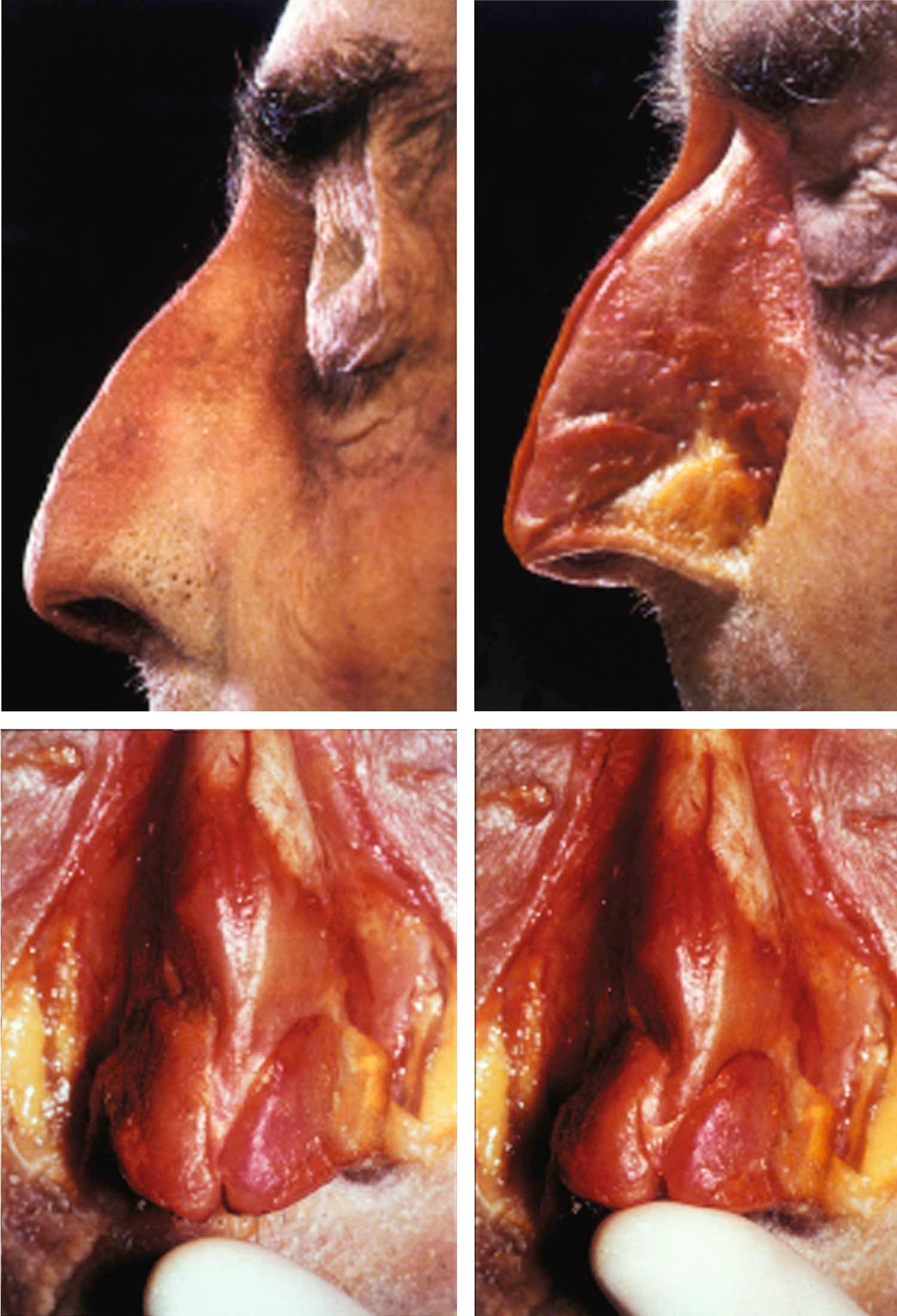
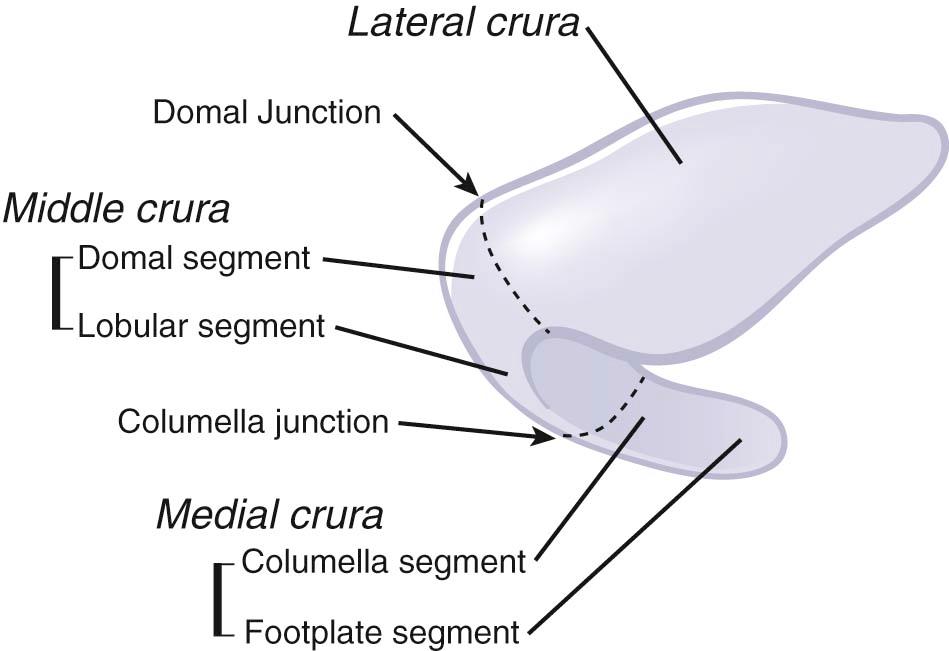
A key component of nasal tip anatomy lies in the scrolled attachment of the cephalic margins of the lower lateral cartilages to the caudal margin of the upper lateral cartilages. This region is often affected during rhinoplasty, which results in weakening of this major source of tip support.
Nasal tip projection is defined as the horizontal distance from the alar crease of the facial plane to the nasal tip on lateral view, or the posterior-to-anterior distance that the nasal tip extends in front of the facial plane as seen on basal view. The analysis of tip projection may be undertaken using several different techniques.
One of the most commonly used measurements is the Goode method, which defines ideal tip projection as a ratio of the distance from the nasion to the tip-defining points. Using the Goode method, this ideal ratio of tip projection to nasal length is 0.55 to 0.6 : 1 ( Figure 25-3, A ). With Simons method, tip projection (defined as the distance between subnasale to the tip-defining point) should equal the height of the upper lip (subnasale to the vermillion border) ( Figure 25-3, B ). Crumley and Lanser described a right triangle with dimensions corresponding to nasal proportions; ideally projection : height : length is equal to 3 : 4 : 5. In other words, ideal tip projection is 75% of the nasal height, measured using a vertical line from the nasion to the nasal base ( Figure 25-3, C ). Powell and Humphries defined the ideal relationship between tip projection and nasal height as a 2.8 : 1 ratio ( Figure 25-3, D ). Byrd and Hobar proposed that ideal projection is two thirds of the ideal nasal length, which is itself ideally two thirds of the midfacial height.
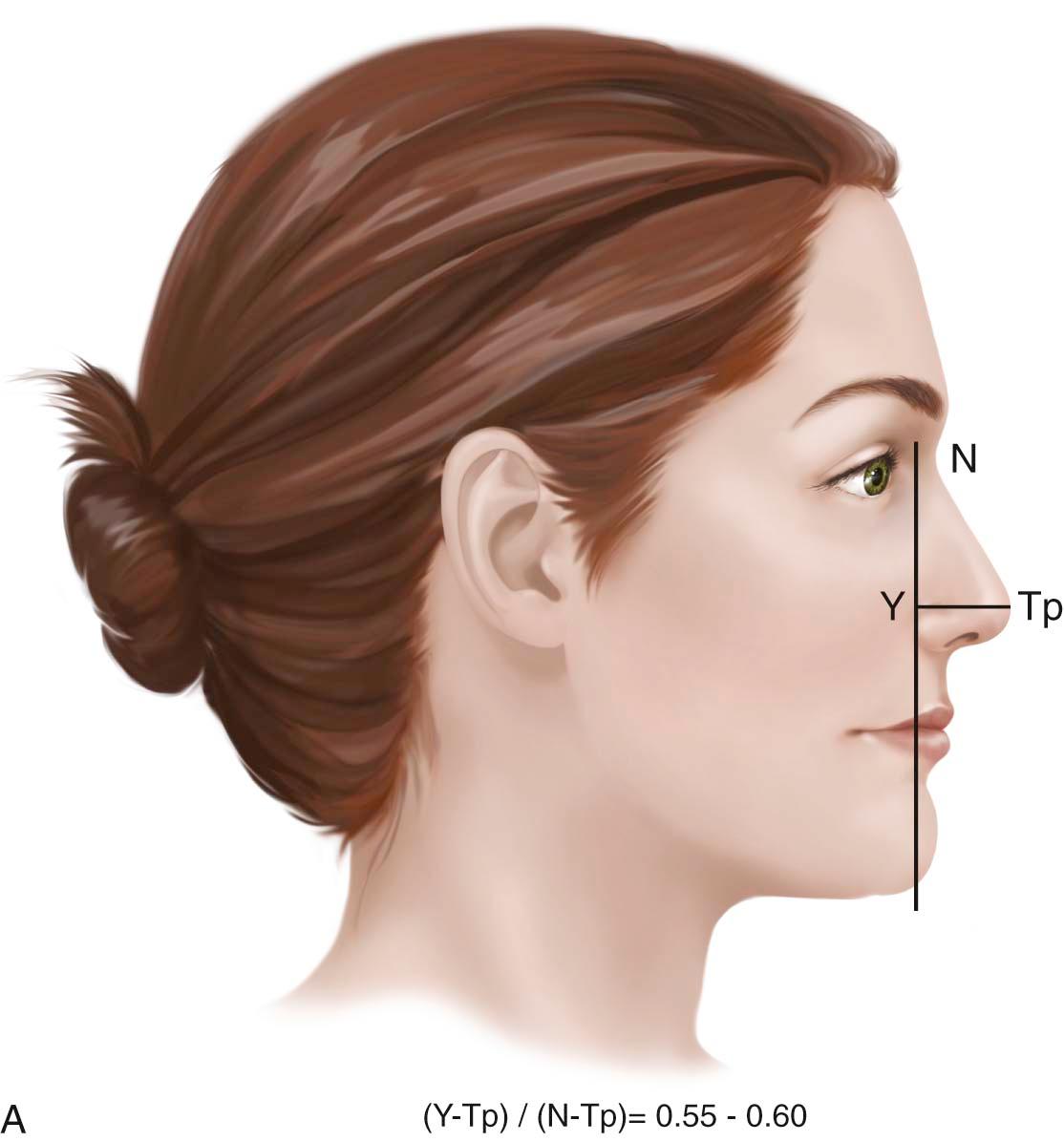
Nasal tip rotation is defined as movement of the nasal tip along an arc with constant distance from the facial plane ( Figure 25-4 ). A ptotic nasal tip may be otherwise described as underrotated. Thus, the terms ptotic and underrotated as applied to the nasal tip are used interchangeably.
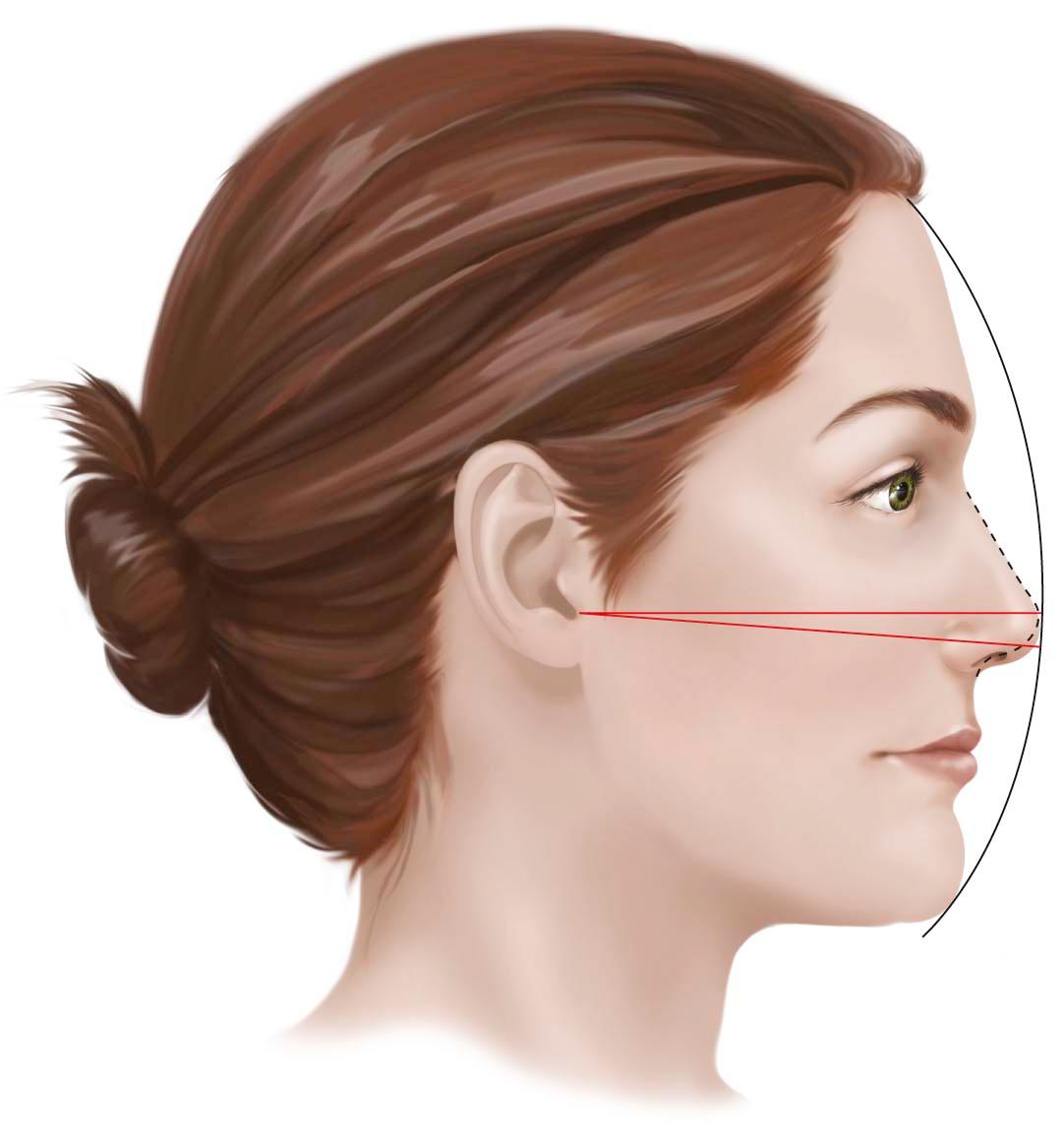
Points of reference used when measuring tip rotation include the upper lip and the Frankfort horizontal plane. When the upper lip is referenced, the nasolabial angle is the angle between the line of the nasal columella and the line of the upper lip. The authors’ preferred method is based upon the Frankfort horizontal plane and the long axis of the nostril ( Figure 25-5 ). The long axis of the nostril is ideally oriented parallel to the columella ( Figure 25-6 ), but often discrepancy exists between the two. When addressed surgically, the long axis of the nostril is first rotated to an angle favorable to the Frankfort horizontal plane, and then the columella is brought into balance with the ala. The ideal angle varies with gender; for women an angle between 10 and 30 degrees is favored, whereas for men an angle between 0 and 15 degrees is considered ideal.
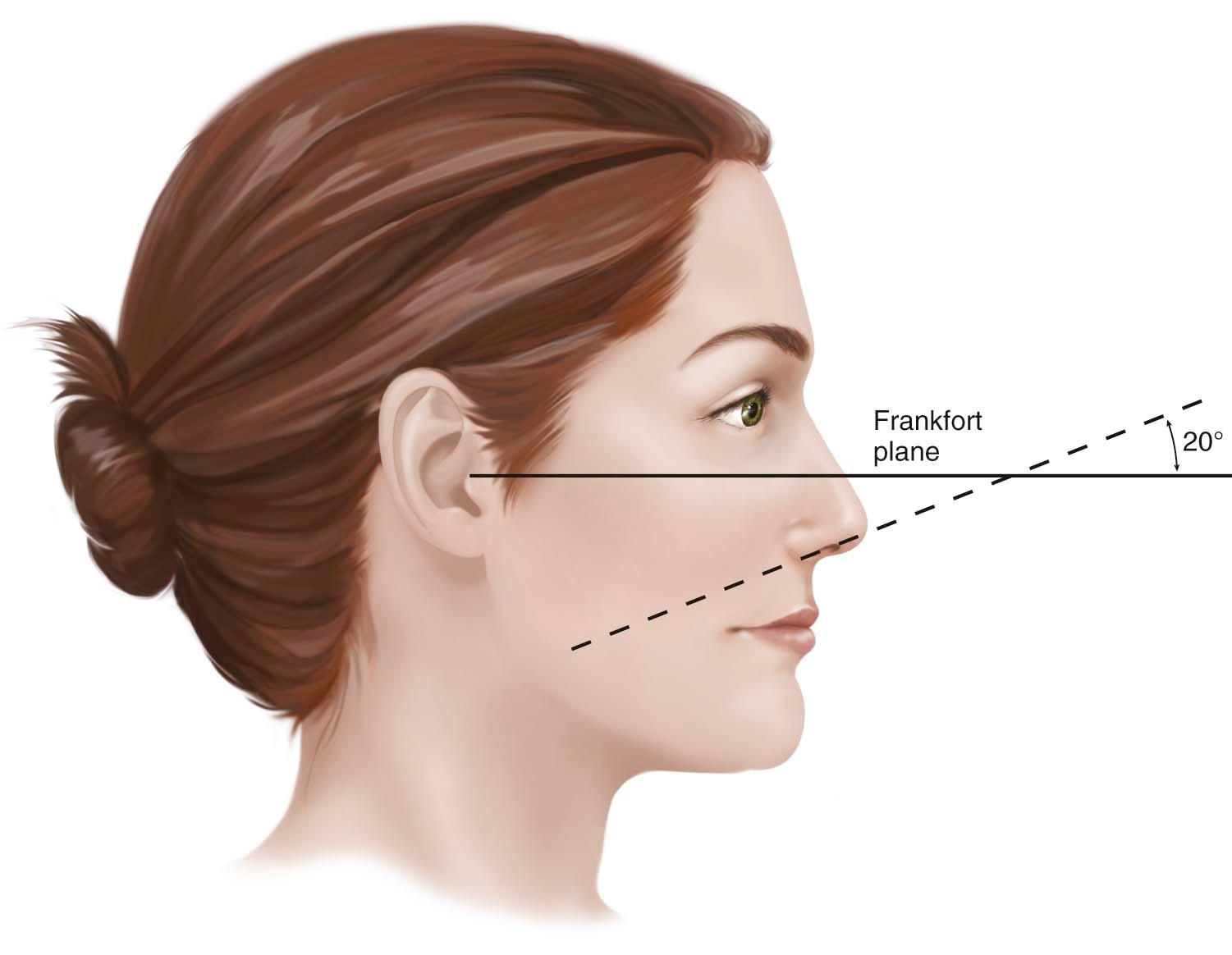
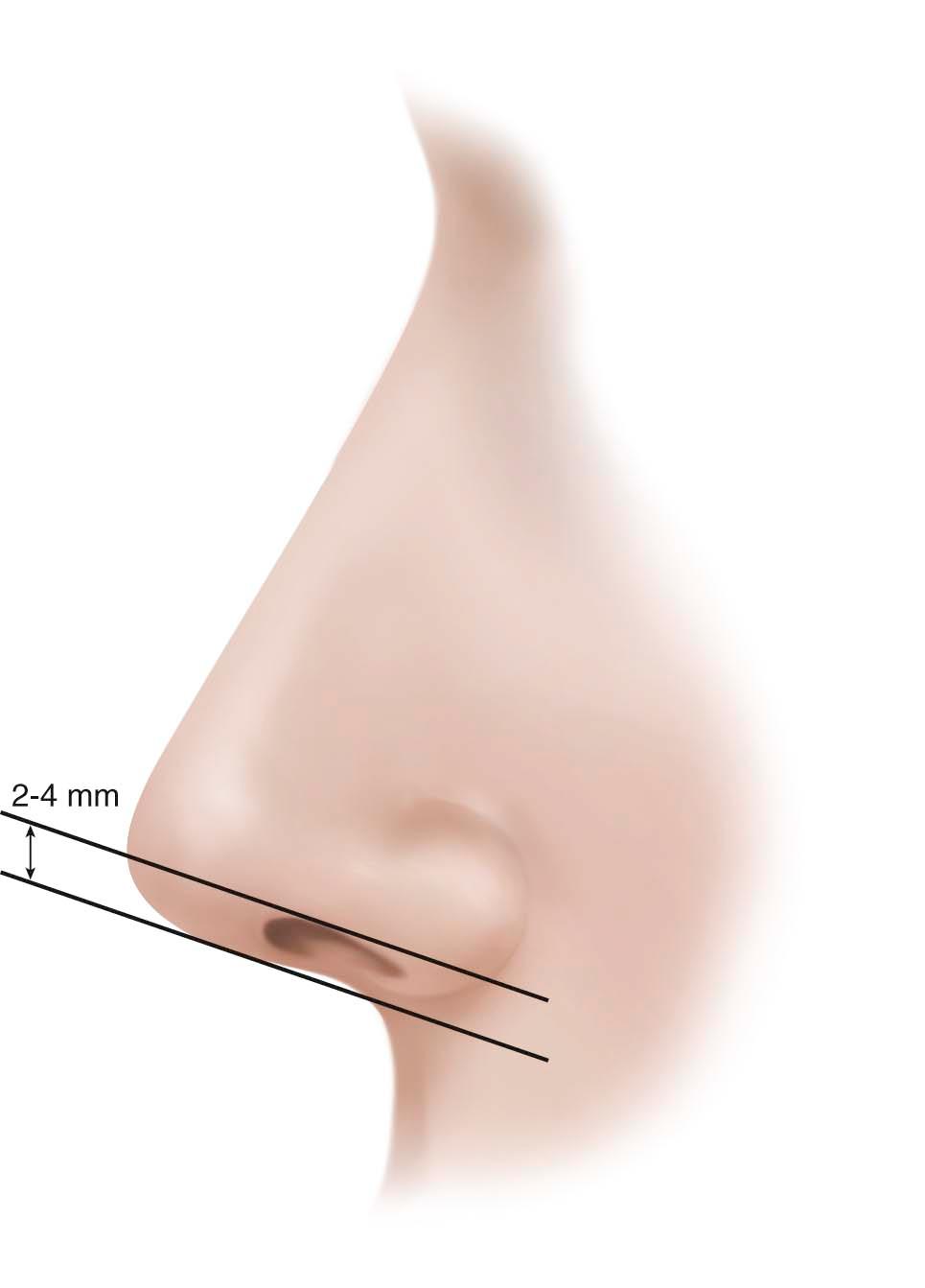
The amount of rotation and projection demonstrated by a nose should be interpreted in relation to the overall nasal appearance. Individual nasal characteristics, including rotation, projection, length, and height, do not exist in a vacuum and should not be evaluated in isolation. Their relevance derives from their contribution to the overall aesthetic balance and proportion of the nose and face. Similarly, illusion plays an important role in nasal appearance. For example, a ptotic nasal tip will appear to be elongated due to the loss of a distinct supratip break. Similarly, excessive dorsal height or a dorsal hump may cause an otherwise well-projected nose to appear to be underprojected as well as elongated. Other facial features contribute to nasal illusions as well; a retrodisplaced pogonion or an anteriorly sloping forehead lends to the illusion of an overprojected nose. These concepts were introduced and are discussed more completely in Chapter 3 of this text.
The structure and position of the nasal tip depend not just on the sum of its constituent parts but also on the support conferred by the upper lateral cartilages, nasal septum, and skin–soft tissue envelope (SSTE). Additionally, the combined effects of age, underlying medical conditions, trauma, and surgical interventions factor prominently in the ultimate appearance of the nasal tip.
To achieve the desired changes to the structure of the nasal tip, the surgeon must understand the factors contributing to tip support and dynamics. Nasal tip support derives from the inherent strength of the lower lateral cartilages, the nasal septum, and the various ligaments and fibrous connections between the alar cartilages and adjacent structures. By convention, support mechanisms are divided into major and minor groups. The three major tip support mechanisms include the size, shape, and resilience of the medial and lateral crura of the lower lateral cartilages, the attachment of the medial crural footplate to the caudal septum, and the scrolled attachment of the cephalic margins of the lower lateral cartilages to the caudal margin of the upper lateral cartilages. The minor tip supports generally include the dorsal septum, interdomal ligaments, membranous septum, anterior nasal spine, attachment of the lower lateral cartilages to the SSTE, the thickness of the SSTE, and the lateral crural attachment to the pyriform aperture ( Table 25-1 ).
| Major Group | Minor Group |
|
|
The interdomal ligament acts to support the nasal tip as a fibrous connection between both domes and the anterior septal angle. The contribution of this ligament is somewhat controversial in that some authors consider the interdomal ligament to be a fourth major tip support mechanism, whereas others consider it to be a minor one.
The tripod model proposed by Jack Anderson provides a mechanical model with which to understand the relationship between projection and rotation. Importantly, it can be used to predict the effects that alar cartilage–modifying maneuvers are likely to have on both tip projection and rotation.
The tripod concept postulates that nasal tip projection and rotation may be understood by considering the nasal tip as a tripod composed of the conjoined medial crura of the lower lateral cartilage as one leg and the two lateral crura as each remaining leg ( Figure 25-7, A ). By changing the length of one component of the tripod, a corresponding change in nasal tip projection and rotation can be anticipated. For example, shortening the two lateral crura would be expected to increase tip rotation along with slight deprojection ( Figure 25-7, B ). Likewise, lengthening the conjoined medial crura alone would increase both projection and rotation ( Figure 25-7, C ).
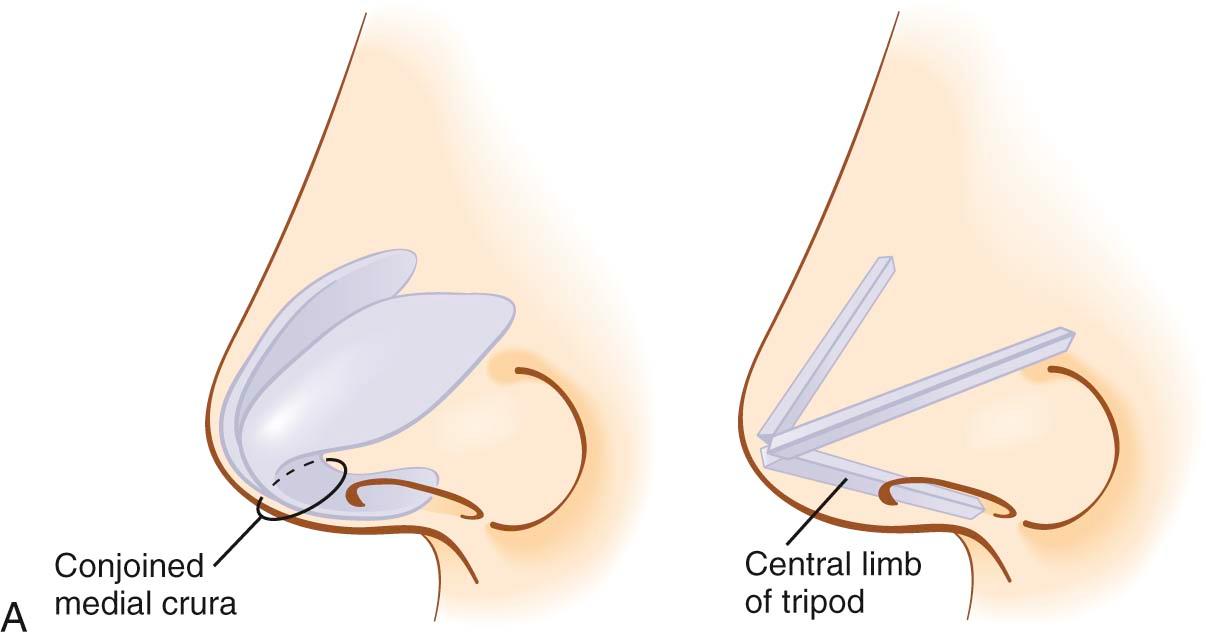
Any condition that weakens the tip support mechanisms just delineated may lead to tip ptosis and underprojection. The range of possible etiologies includes congenital weakness of the nasal cartilages or other tip support mechanisms, infection, trauma, and iatrogenic damage.
For each patient, the etiology of ptosis and underprojection should be investigated to elucidate the contributing factors. To ensure success, the surgical plan must address the specific issues pertinent to each case.
Iatrogenic causes of tip ptosis and underprojection are common. Patients with a history of prior septorhinoplasty are at risk for developing tip sequelae due to surgical disruption of tip support mechanisms. Additionally, the effects of scar contracture of the disrupted SSTE further contributes over time to postoperative tip ptosis and deprojection.
Practically every maneuver associated with the endonasal approach compromises tip support mechanisms, including the intercartilaginous incision and the alar cephalic trim. A cadaveric study using objective measurements found that the intercartilaginous incisions and cartilage delivery techniques inherent to the endonasal approach caused a 35% loss of tip support. Alar cartilage–splitting techniques and aggressive cartilage resection further compromise nasal structure and support mechanisms.
There is controversy as to the relative destructuring effects of the endonasal approach versus the nasal decortication undertaken with the open approach. The authors’ opinion is that although the open approach to rhinoplasty is referred to as simply another approach, in reality it is another operation entirely. The open approach necessitates rebuilding injured tip support that is compromised as part of the decortication.
In the operated nose, ptosis and underprojection are typically not apparent in the early postoperative period. However, with passing time, the effects of scar contracture and gravity often create conditions that cannot be withstood by the diminished structure of the operated nose. Likewise, the effects of skin envelope contracture are only seen over time and through hindsight the need for more structure is elucidated.
The authors prefer the open approach to the nose if any tip work is required, as is the case in the great majority of our nasal cases. Methods of repair may be divided into alar cartilage–modifying techniques and adjunctive maneuvers.
Alar cartilage–modifying techniques to address tip underrotation and underprojection include placement of a columellar strut, tip grafting, lateral crural steal, lateral crural overlay, and the tongue-in-groove techniques. Adjunctive maneuvers include establishing proper dorsal height, addressing alar–columellar discrepancy, premaxillary grafting, alar cephalic trim, resection of an overdeveloped scroll region, and debulking the SSTE. Each of these options will be described next.
The surgical techniques described in this chapter may be used either independently or in combination depending on the findings and contributing factors present in each case, as well as on the degree of rotation or projection intended.
Throughout the course of a rhinoplasty, often cartilaginous grafting material is needed to provide the structural support required to affect desired changes. The preferred grafting materials are septal cartilage followed by auricular cartilage, then costal cartilage. In the unoperated nose, sufficient septal cartilage is usually available to enable its use in most cases. In revision cases, the surgeon should investigate the status of the septal cartilage, while retaining a backup plan should insufficient septal cartilage be found at the time of surgery. A paucity of remaining septal cartilage requires that the surgeon find another source. As a matter of course, revision cases should be counseled about and consented for auricular and costal cartilage harvest in the event the need arises for alternative sources of cartilaginous grafting material.
When septal cartilage is found to be inadequate, auricular cartilage should be sought. A cartilage incision is made along the inner rim of the antihelical fold, while preserving a strip of intact cartilage between the cymba concha superiorly and the concha cavum inferiorly, which the authors prefer to harvest separately. Preservation of this auricular cartilage strut enables the healing auricle to resist contraction and deformation during healing, thus preserving the anteroposterior dimension of the conchal bowl.
The concha cavum is the preferred auricular substrate for tip grafting if septal cartilage is unavailable, while the cymba concha is the favored source of alar grafting material. When used for a columellar strut, the concha cavum or concha cymba is reinforced by folding it upon itself, with concave surfaces facing each other, and sutured together using multiple 5-0 nylon sutures in a horizontal mattress fashion.
Become a Clinical Tree membership for Full access and enjoy Unlimited articles
If you are a member. Log in here